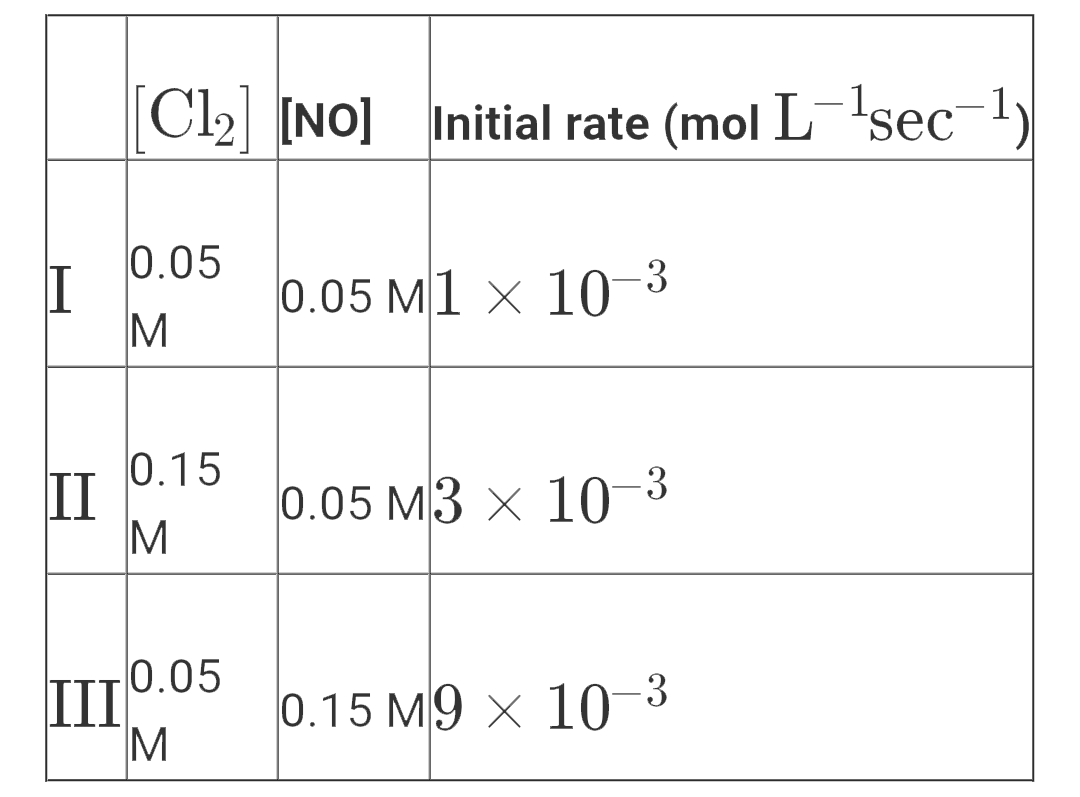Nitric oxide (NO) reacts with oxygen to produce nitrogen dioxide
2NO(g)+O2(g)→2N2(g)
If the mechanism of reaction is
NO+O2K⇐⇒NO3 (fast)
NO3+NOK1−−→NO2+NO2 (slow)
then rate law is
Rate =K'[NO][O2]
Rate =K'[NO][O2]2
Rate =K'[NO]2[O2]
Rate =K'[NO]3[O2]
The correct Answer is:C
To determine the rate law for the reaction of nitric oxide (NO) with oxygen (O₂) to produce nitrogen dioxide (NO₂), we will analyze the provided reaction mechanism step by step.
Step 1: Identify the Reaction Steps
The reaction mechanism is given as:
1. NO+O2K⇌NO3 (fast, equilibrium step)
2. NO3+NOK1→2NO2 (slow step)
Step 2: Determine the Rate Law from the Slow Step
The rate of the overall reaction is determined by the slowest step in the mechanism. Therefore, the rate law can initially be written based on the slow step:
Rate=K1(NO3)(NO)
Step 3: Identify the Intermediate
In this case, NO3 is an intermediate, which means it does not appear in the overall balanced equation. To express the rate law without the intermediate, we need to eliminate (NO3) from the equation.
Step 4: Use the Equilibrium Expression
From the first step, which is an equilibrium step, we can write the equilibrium constant K:
K=(NO3)(NO)(O2)
From this, we can express (NO3) in terms of the other concentrations:
(NO3)=K(NO)(O2)
Step 5: Substitute the Intermediate into the Rate Law
Now, substitute (NO3) back into the rate law:
Rate=K1(K(NO)(O2))(NO)
This simplifies to:
Rate=K1K(NO)2(O2)
Step 6: Define the Rate Constant
Let k′=K1K (a new constant that combines both constants). Thus, the final rate law can be expressed as:
Rate=k′(NO)2(O2)
Final Answer
The rate law for the reaction is:
Rate=k′(NO)2(O2)
The reaction mechanism is given as:
1. NO+O2K⇌NO3 (fast, equilibrium step)
2. NO3+NOK1→2NO2 (slow step)
The rate of the overall reaction is determined by the slowest step in the mechanism. Therefore, the rate law can initially be written based on the slow step:
Rate=K1(NO3)(NO)
In this case, NO3 is an intermediate, which means it does not appear in the overall balanced equation. To express the rate law without the intermediate, we need to eliminate (NO3) from the equation.
From the first step, which is an equilibrium step, we can write the equilibrium constant K:
K=(NO3)(NO)(O2)
From this, we can express (NO3) in terms of the other concentrations:
(NO3)=K(NO)(O2)
Now, substitute (NO3) back into the rate law:
Rate=K1(K(NO)(O2))(NO)
This simplifies to:
Rate=K1K(NO)2(O2)
Let k′=K1K (a new constant that combines both constants). Thus, the final rate law can be expressed as:
Rate=k′(NO)2(O2)
The rate law for the reaction is:
Rate=k′(NO)2(O2)
Topper's Solved these Questions
- CHEMICAL KINETICSBOOK - AAKASH INSTITUTE ENGLISHCHAPTER - CHEMICAL KINETICSEXERCISE - ASSIGNMENT (SECTION C : Previous Year Questions)
62 Videos
- CHEMICAL KINETICSBOOK - AAKASH INSTITUTE ENGLISHCHAPTER - CHEMICAL KINETICSEXERCISE - ASSIGNMENT (SECTION D : Assertion - Reason Type Questions)
15 Videos
- CHEMICAL KINETICSBOOK - AAKASH INSTITUTE ENGLISHCHAPTER - CHEMICAL KINETICSEXERCISE - ASSIGNMENT (SECTION A : Objective Type Questions)
50 Videos
- CHEMICAL BONDING AND MOLECULAR STRUCTURE BOOK - AAKASH INSTITUTE ENGLISHCHAPTER - CHEMICAL BONDING AND MOLECULAR STRUCTURE EXERCISE - Assignment Section J (Aakash Challengers Questions)
10 Videos
- CHEMISTRY IN EVERYDAY LIFE BOOK - AAKASH INSTITUTE ENGLISHCHAPTER - CHEMISTRY IN EVERYDAY LIFE EXERCISE - Assignment ( SECTION - A)
45 Videos
Similar Questions
Nitric oxide reacts with oxygen to produce nitrogen dioxide.
2NO(g)+O2(g)→2NO2(g)
What is the predicted rate law and order if the mechanism is:
(i)NO+O2K⇐⇒NO3 ( fast)
(ii)NO3+NOK1⇐⇒NO2+NO2 ( slow)
View SolutionNitric oxide reacts with oxygen to produce nitrogen dioxide.
2NO(g)+O2(g)→2NO2(g)
What is the predicted rate law and order if the mechanism is:
(i)NO+O2K⇐⇒NO3 ( fast)
(ii)NO3+NOK1⇐⇒NO2+NO2 ( slow)
View Solution
Knowledge Check
For a reaction, 2N2O5(g)→4NO2(g)+O2(g) rate of reaction is:
ARate =−d[N2O5]dt=−14d[NO2]dt=12d[O2]dtBRate =−12d[n2O5]dt=14d[NO2]dt=d[O2]2CRate =−14d[N2O5]dt=12d[NO2]dt=d[O2]dtDRate =−12d[N2O5]dt=12d[NO2]dt=12d[O2]dt
Nitric oxide reacts with oxygen to produce nitrogen dioxide.
2NO(g)+O2(g)→2NO2(g)
What is the predicted rate law and order if the mechanism is:
(i)NO+O2K⇐⇒NO3 ( fast)
(ii)NO3+NOK1⇐⇒NO2+NO2 ( slow)
View SolutionNitric oxide NO reacts with oxygen to produce nitrogen dioxide:
2NO(g)+O2(g)→2NO2(g)
The rate law for this reaction is rate =k[NO]2[O2]
Propose a mechanism for the above reaction.
View SolutionIn the following reaction:
2NO(g)+O2(g)k'−−→2NO2(g)
What is the predicted rate law, if the mechanism is
NO+O2(g)keq⇐⇒NO3(fast) (fast)
NO3+NOk1−−→NO2+NO2 (slow)
View SolutionThe given data are for the reaction, 2NO(g)+Cl(g)→2NOCl(g) at 298K

The rate law of the reactions is
View SolutionHow will the rate of reaction
2SO2(g)+O2(g)→2SO3(g) change if the volume of the reaction vessel is halved?
View SolutionNitrogen dioxide (NO2) reacts with fluorine (F2) to yield nitryl fluoride (NO2F).
2NO2(g)+F2(g)→2NO2F(g)
Write the rate of reaction in terms of
rate of formation of NO2F
View SolutionNitrogen dioxide (NO2) reacts with fluorine (F2) to yield nitryl fluoride (NO2F).
2NO2(g)+F2(g)→2NO2F(g)
Write the rate of reaction in terms of
rate of formation of NO2F
View Solution